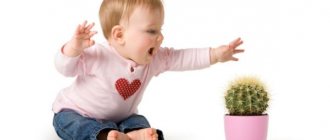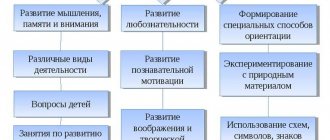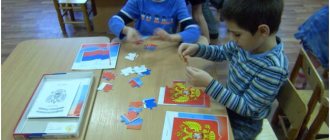Methods and means of implementing research activities
The level of development of older preschoolers allows them to express themselves in any of the considered types of cognitive and research activities. Gifted children are especially active in this direction. But every child can be stirred up, a spark of curiosity can be ignited in him and pushed towards a deeper comprehension of the surrounding reality.
There are two main forms of cognitive and research activity:
- The child is the source of activity. He sets a goal himself and strives to achieve it, satisfying his curiosity.
- The research process is organized by an adult, awakening interest and motivating knowledge. A preschooler learns to act.
Each of these forms is aimed at solving a single task: to help the child understand a problematic issue, firmly assimilate new knowledge and gain new experience.
Methods and techniques for organizing research activities of preschoolers vary from conversations to carrying out small projects to obtain a specific result. They are widely used in preschool educational institutions. Also perfect for home use.
Developmental conversations
When it comes to developmental conversations, the dialogue should motivate the child not only to receive ready-made information, but also to the desire to reflect, analyze and draw conclusions.
For example, a preschooler became interested in why hail suddenly fell in the middle of summer. There is no need to rush with explanations. Explain what each hailstone is, why drops of water freeze, and what happened in the atmosphere the day before. The child thinks, builds a logical chain and formulates his assumption. Some correction may be required, but the young researcher will already be able to draw a conclusion.
Or a child has heard a new word and wonders what it means. Let your son or daughter think about it, and only at the end comment and formulate the child’s thought more clearly.
Organization of observations
You can observe with your child living nature (animals, insects, plants), inanimate nature (seasonal changes and natural phenomena) and social life. When organizing observations, it is necessary to determine:
- observation location (park, meadow, pond, urban environment);
- object of observation (plant, animal, inanimate object).
If necessary, prepare and take with you special instruments (magnifying glass, thermometer, etc.) or items (bird food, brushes, etc.).
Summer weather conditions contribute to the cognitive and research activities of preschool children. The organization of observations at this time of year is aimed both at strengthening the child’s health and at creating conditions in which he could prove himself as an inquisitive researcher of the world around him.
You can organize observation at home. For example, growing onions. Game motivation works well: let’s set up a garden bed on the windowsill.
The child, with the help of an adult, pours water into cups, “plants” bulbs in them and places them on the windowsill. Joint observation of the bulbs is carried out for several days. You can keep an “Observation Sheet” and record changes using sketches. When the onion arrows are long enough, you can cut them off and crumble them into your child’s soup. He will be happy to try vitamins from his own garden.
Experiences and Experiments
In order for transformations in the world around them not only to be noticed by the child, but also to become an impetus for the development of his thinking, the preschooler must, while performing the task, be in the position of not a spectator, but a researcher. Therefore, it is so important that adults organize and conduct experiments and experiments together with the child.
The most interesting experiments are experiments with objects. The well-known experiment “Drowning or not drowning” will require simple equipment: a bowl of water, several objects from different materials (a feather, a nail, a plastic ball, a clothespin, a bead, a piece of paper, etc.).
During the experiment, the child must distribute objects according to the criterion “drowning or not drowning”:
- Sinks immediately;
- Sinks after getting wet;
- Doesn't sink.
The preschooler independently checks the “buoyancy” of each object. A preliminary inspection and tactile examination of objects will indicate what qualities of objects affect the result of interaction with water.
Involvement in projects
In modern kindergartens, the method of project activities is widely used. Basically, three types of projects are addressed:
- research (study of certain phenomena);
- creative (creating a creative product);
- normative (joint creation of a set of rules).
The organization of project-based cognitive and research activities allows children to be included in a common cause and create a joint creative product.
You can just as easily organize a project at home for your children or for a child and his friends.
For example, get excited about creating a general drawing on a large sheet of paper. And at the same time, you can jointly prepare unusual, magical paints (based on flour, salt and gouache). It is convenient to apply such paints onto the sheet directly by hand, which is extremely attractive to children.
Development of research skills in preschool children
The development of a child’s research abilities largely depends on the position of adults. After all, children themselves are not able to fully organize their activities and evaluate the results obtained.
Therefore, adults should motivate children to complete interesting tasks, stimulate non-standard and interesting solutions, and help the child evaluate the level of the proposed solutions.
At the same time, it is necessary to provide maximum opportunities for independent action and support the initiative of the preschooler.
Activation of cognitive interest
Despite the fact that children have a natural need for knowledge, their interest and search activity must be stimulated. To do this, you can use tasks to develop the skills of thinking originally, seeing problems, and reasoning from different points of view.
Exercises and tasks for this purpose are varied. Here are just a few of them:
- Write a story on behalf of Kolobok (the hero can be anyone);
- Come up with several answers to heuristic questions (Why do birds sing?);
- Exercises to develop the ability to ask questions (“Ask questions to the funny bunny in the picture to find out about him”);
- Conduct a thought experiment (“What would happen if all people became giants?”);
- Experiments with real objects in order to identify new properties (with water, paints, a ray of light, plastic, fabric);
- Games for the development of thinking (“Sequential pictures”, “Fairy tales” and others).
Encouraging child independence
Research and search activities will bring little benefit to a preschooler if he is only an observer. It is not enough that the child just performs the actions. It is important that he sets goals on his own, what he wants to check, learn, understand. And having identified a goal, he acted in accordance with it.
In order to consistently develop the child’s independence, parents need to adhere to the following rules:
- Create an environment in your home that encourages your child's independence.
- Give us the opportunity to solve small problem situations.
- Maintain interest in the activity.
- Measure your level of activity in joint activities with your child.
- Don't blame yourself for failures. Explore their reasons together.
- Praise your child for success. It is very important!
The influence of cognitive research activities on the formation of readiness for school
Involving a preschooler in cognitive and research activities gives him a good foundation for his upcoming schooling. This type of activity ensures a strong assimilation of knowledge and develops the desire to learn new things.
The child learns to formulate goals, reason logically, adhere to an algorithm in actions, control steps, and evaluate the results obtained. All of the above permeates educational activities at school.
In addition, search efforts form voluntary attention and influence the development of volitional qualities of a preschooler. The child has to repeat experiments, return to observations in order to find answers to problematic questions.
Thus, a cognitive-exploratory attitude towards the world around us comprehensively develops a preschooler and increases his readiness for learning at school.



